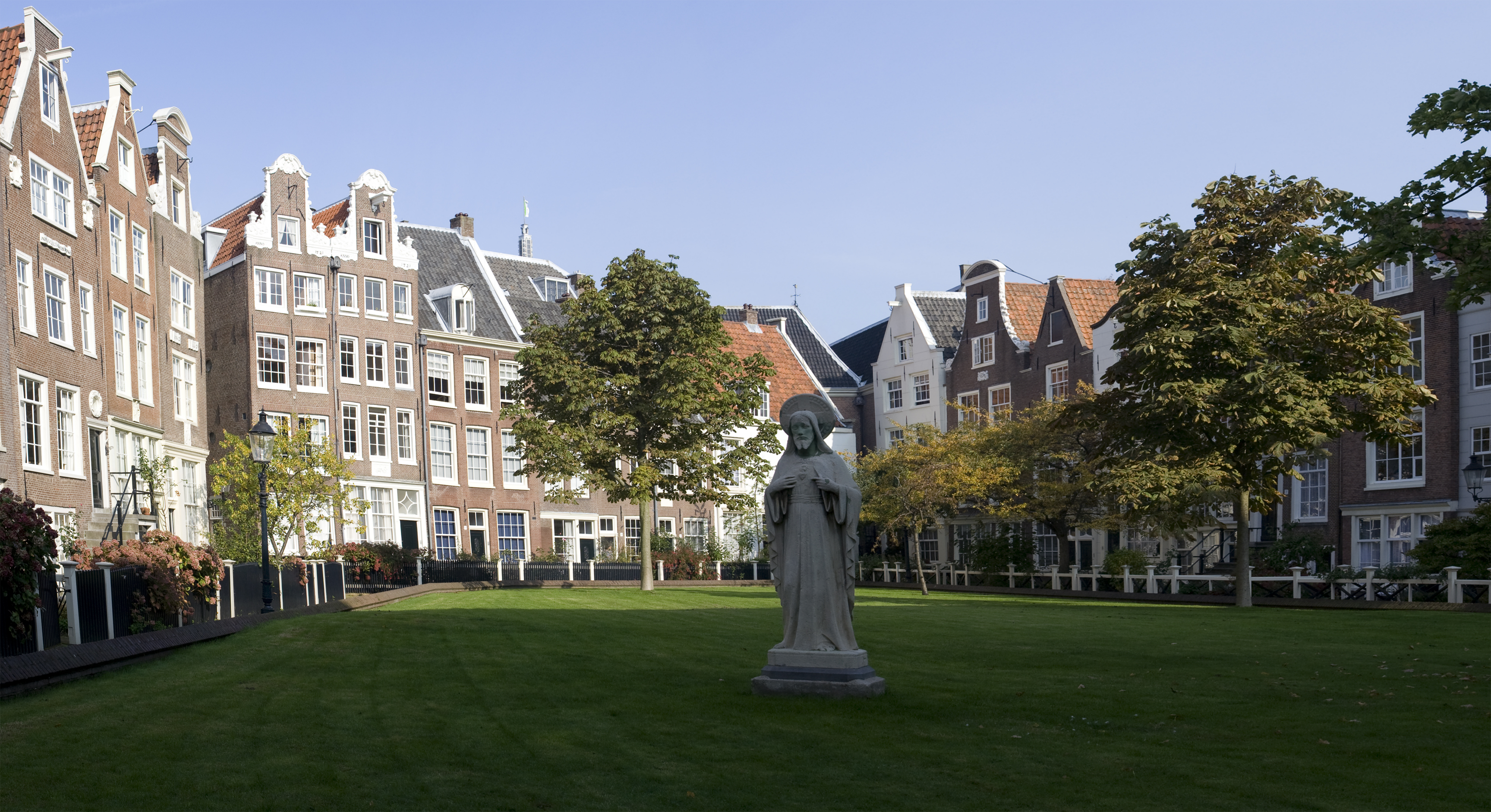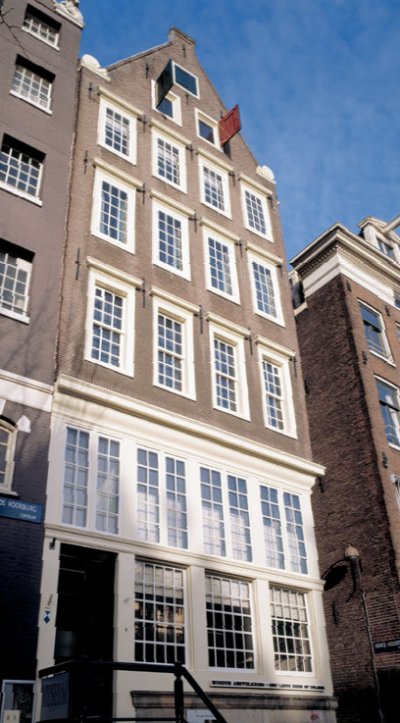|
Begijnhof, Amsterdam
The Begijnhof is one of the oldest hofjes in Amsterdam, Netherlands. A group of historic buildings, mostly private dwellings, centre on it. As the name suggests, it was originally a Béguinage. Today it is also the site of two churches, the Catholic ''Houten Huys'' and the English Reformed Church. Earliest times The Begijnhof is the only inner court in Amsterdam which was founded during the Middle Ages, and therefore lies within the Singel — the innermost canal of Amsterdam's circular canal system. The Begijnhof is at medieval street level, which means a meter below the rest of the old city center. It is unclear when exactly the Begijnhof (Beguines' court) was founded. In 1346, the beguines still lived in a house (a document of that time mentioned one ''beghynhuys''). A courtyard was only first mentioned in 1389, probably after the religious status of the city rose due to the Amsterdam Eucharistic Miracle of 1345. Originally the Begijnhof was entirely encircled by water (t ... [...More Info...] [...Related Items...] OR: [Wikipedia] [Google] [Baidu] |
Gothic Architecture
Gothic architecture (or pointed architecture) is an architectural style that was prevalent in Europe from the late 12th to the 16th century, during the High and Late Middle Ages, surviving into the 17th and 18th centuries in some areas. It evolved from Romanesque architecture and was succeeded by Renaissance architecture. It originated in the Île-de-France and Picardy regions of northern France. The style at the time was sometimes known as ''opus Francigenum'' (lit. French work); the term ''Gothic'' was first applied contemptuously during the later Renaissance, by those ambitious to revive the architecture of classical antiquity. The defining design element of Gothic architecture is the pointed or ogival arch. The use of the pointed arch in turn led to the development of the pointed rib vault and flying buttresses, combined with elaborate tracery and stained glass windows. At the Abbey of Saint-Denis, near Paris, the choir was reconstructed between 1140 and 1144, draw ... [...More Info...] [...Related Items...] OR: [Wikipedia] [Google] [Baidu] |
Begijnhof Chapel (Amsterdam)
The Begijnhof Chapel, dedicated to Saint John and Saint Ursula, is a Roman Catholic chapel run by the Congregation of the Blessed Sacrament, in the St Nicholas Parish of Amsterdam. It is located in a former schuilkerk in the Begijnhof across from its original location, the English Reformed Church, Amsterdam. The Miracle of Amsterdam is commemorated yearly with a procession starting from this church. History Around 1150, a group of women came together to live in a religious community, primarily to look after the sick. These were the first 'Beguines’ although the name was not yet used. The women were not nuns and nor did they live in the seclusion of a convent. They had no founders nor did they make lifelong vows. They were unmarried women who made a vow of chastity and promised obedience to the parish priest, but since they were not expected to make a vow of poverty, they were free to dispose of their own possessions as they wished. They could renounce their vows at any moment ... [...More Info...] [...Related Items...] OR: [Wikipedia] [Google] [Baidu] |
Schuilkerk
A clandestine church ( nl, schuilkerk), defined by historian Benjamin J. Kaplan as a "semi-clandestine church", is a house of worship used by religious minorities whose communal worship is tolerated by those of the majority faith on condition that it is discreet and not conducted in public spaces. ''Schuilkerken'' are commonly built inside houses or other buildings, and do not show a public façade to the street. They were an important advance in religious tolerance in the wake of the Reformation, an era when worship services conducted by minority faiths were often banned and sometimes penalized by exile or execution. History According to historian Benjamin Kaplan, clandestine churches became common in Europe in the wake of the Reformation as a way for governments to permit a degree of religious toleration for minority Christian denominations and Jews. Both political and religious considerations frequently led governments to ban all worship not sanctioned by the state, and in ma ... [...More Info...] [...Related Items...] OR: [Wikipedia] [Google] [Baidu] |
Philip Vingboons
Philips Vingboons (or ''Vinckboons'', ''Vinckeboons'', ''Vinckbooms'') ( – 2 October 1678) was a Dutch architect. He was part of the school of Jacob van Campen, that is, Dutch Classicism. Vingboons was especially highly regarded in his native city of Amsterdam. Biography Philips Vingboons was born in circa 1607 in Amsterdam in the Dutch Republic.Philips Vinckboons II in the His father was a from the |
Piet Mondrian
Pieter Cornelis Mondriaan (), after 1906 known as Piet Mondrian (, also , ; 7 March 1872 – 1 February 1944), was a Dutch painter and art theoretician who is regarded as one of the greatest artists of the 20th century. He is known for being one of the pioneers of 20th-century abstract art, as he changed his artistic direction from figurative painting to an increasingly abstract style, until he reached a point where his artistic vocabulary was reduced to simple geometric elements. Mondrian's art was highly utopian and was concerned with a search for universal values and aesthetics. He proclaimed in 1914: "Art is higher than reality and has no direct relation to reality. To approach the spiritual in art, one will make as little use as possible of reality, because reality is opposed to the spiritual. We find ourselves in the presence of an abstract art. Art should be above reality, otherwise it would have no value for man." His art, however, always remained rooted in nature. H ... [...More Info...] [...Related Items...] OR: [Wikipedia] [Google] [Baidu] |
Pulpit
A pulpit is a raised stand for preachers in a Christian church. The origin of the word is the Latin ''pulpitum'' (platform or staging). The traditional pulpit is raised well above the surrounding floor for audibility and visibility, accessed by steps, with sides coming to about waist height. From the late medieval period onwards, pulpits have often had a canopy known as the sounding board, ''tester'' or ''abat-voix'' above and sometimes also behind the speaker, normally in wood. Though sometimes highly decorated, this is not purely decorative, but can have a useful acoustic effect in projecting the preacher's voice to the congregation below. Most pulpits have one or more book-stands for the preacher to rest his or her bible, notes or texts upon. The pulpit is generally reserved for clergy. This is mandated in the regulations of the Catholic Church, and several others (though not always strictly observed). Even in Welsh Nonconformism, this was felt appropriate, and in some ... [...More Info...] [...Related Items...] OR: [Wikipedia] [Google] [Baidu] |
Presbyterianism
Presbyterianism is a part of the Reformed tradition within Protestantism that broke from the Roman Catholic Church in Scotland by John Knox, who was a priest at St. Giles Cathedral (Church of Scotland). Presbyterian churches derive their name from the presbyterian form of church government by representative assemblies of elders. Many Reformed churches are organised this way, but the word ''Presbyterian'', when capitalized, is often applied to churches that trace their roots to the Church of Scotland or to English Dissenter groups that formed during the English Civil War. Presbyterian theology typically emphasizes the sovereignty of God, the authority of the Scriptures, and the necessity of grace through faith in Christ. Presbyterian church government was ensured in Scotland by the Acts of Union in 1707, which created the Kingdom of Great Britain. In fact, most Presbyterians found in England can trace a Scottish connection, and the Presbyterian denomination was also taken ... [...More Info...] [...Related Items...] OR: [Wikipedia] [Google] [Baidu] |
Roman Catholic Church
The Catholic Church, also known as the Roman Catholic Church, is the largest Christian church, with 1.3 billion baptized Catholics worldwide . It is among the world's oldest and largest international institutions, and has played a prominent role in the history and development of Western civilization.O'Collins, p. v (preface). The church consists of 24 ''sui iuris'' churches, including the Latin Church and 23 Eastern Catholic Churches, which comprise almost 3,500 dioceses and eparchies located around the world. The pope, who is the bishop of Rome, is the chief pastor of the church. The bishopric of Rome, known as the Holy See, is the central governing authority of the church. The administrative body of the Holy See, the Roman Curia, has its principal offices in Vatican City, a small enclave of the Italian city of Rome, of which the pope is head of state. The core beliefs of Catholicism are found in the Nicene Creed. The Catholic Church teaches that it is th ... [...More Info...] [...Related Items...] OR: [Wikipedia] [Google] [Baidu] |
Calvinism
Calvinism (also called the Reformed Tradition, Reformed Protestantism, Reformed Christianity, or simply Reformed) is a major branch of Protestantism that follows the theological tradition and forms of Christian practice set down by John Calvin and other Reformation-era theologians. It emphasizes the sovereignty of God and the authority of the Bible. Calvinists broke from the Roman Catholic Church in the 16th century. Calvinists differ from Lutherans (another major branch of the Reformation) on the spiritual real presence of Christ in the Lord's Supper, theories of worship, the purpose and meaning of baptism, and the use of God's law for believers, among other points. The label ''Calvinism'' can be misleading, because the religious tradition it denotes has always been diverse, with a wide range of influences rather than a single founder; however, almost all of them drew heavily from the writings of Augustine of Hippo twelve hundred years prior to the Reformation. The na ... [...More Info...] [...Related Items...] OR: [Wikipedia] [Google] [Baidu] |
Protestant Reformation
The Reformation (alternatively named the Protestant Reformation or the European Reformation) was a major movement within Western Christianity in 16th-century Europe that posed a religious and political challenge to the Catholic Church and in particular to papal authority, arising from what were perceived to be errors, abuses, and discrepancies by the Catholic Church. The Reformation was the start of Protestantism and the split of the Western Church into Protestantism and what is now the Roman Catholic Church. It is also considered to be one of the events that signified the end of the Middle Ages and the beginning of the early modern period in Europe.Davies ''Europe'' pp. 291–293 Prior to Martin Luther, there were many earlier reform movements. Although the Reformation is usually considered to have started with the publication of the '' Ninety-five Theses'' by Martin Luther in 1517, he was not excommunicated by Pope Leo X until January 1521. The Diet of Worms of May 1521 ... [...More Info...] [...Related Items...] OR: [Wikipedia] [Google] [Baidu] |
Patron Saint
A patron saint, patroness saint, patron hallow or heavenly protector is a saint who in Catholicism, Anglicanism, or Eastern Orthodoxy is regarded as the heavenly advocate of a nation, place, craft, activity, class, clan, family, or person. In Christianity Saints often become the patrons of places where they were born or had been active. However, there were cases in Medieval Europe where a city which grew to prominence and obtained for its cathedral the remains or some relics of a famous saint who had lived and was buried elsewhere, thus making them the city's patron saint – such a practice conferred considerable prestige on the city concerned. In Latin America and the Philippines, Spanish and Portuguese explorers often named a location for the saint on whose feast or commemoration day they first visited the place, with that saint naturally becoming the area's patron. Occupations sometimes have a patron saint who had been connected somewhat with it, although some of ... [...More Info...] [...Related Items...] OR: [Wikipedia] [Google] [Baidu] |

.jpg)





.jpg)
.jpg)
